|
|
|
|
|
|
|
INTERIOR
SECRETARY SALAZAR VISITS BASIN
|
|
On
August 15, Senator Patrick Leahy hosted Interior Secretary Ken Salazar
for a tour of the Vermont lakeshore. During the visit, Sen. Leahy and
Sec. Salazar, joined by Governor Peter Shumlin, announced the final
approval of the management plan for the Champlain Valley National
Heritage Partnership (CVNHP) and the U.S. Fish & Wildlife Service's
(USFWS) new leadership role in sea lamprey control in the Basin.
|
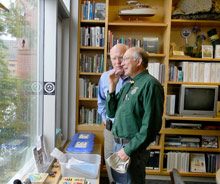
|
|
Senator Leahy and
Secretary Salazar share a view of Lake Champlain from the LCBP
Resource Room.
|
Sen.
Leahy and Sec. Salazar started the day with a visit to the Missisquoi
National Wildlife Refuge, managed by USFWS, an Interior Department
agency and LCBP partner with a pivotal role in managing the Basin's
natural resources. The tour ended at the Leahy Center for Lake
Champlain, where the Secretary and Senator toured the ECHO Lake
Aquarium and Science Center and LCBP's Resource Room. The Secretary
also inspected the USGS gaging station on the waterfront and the Lois
McClure, the Lake Champlain Maritime Museum's replica canal schooner.
Between these stops, Sen.
Leahy and Sec. Salazar joined Governor Shumlin for a press conference
at Biben's Ace Hardware on Mallets Bay in Colchester, where the
Secretary emphasized the economic benefits of conservation and
recreation initiatives such as heritage recreation and improved
fisheries. The CVNHP, established by legislation co-written by Sen.
Leahy and former Sen. Jim Jeffords, is expected to generate substantial
new business revenues throughout the region each year. The ongoing sea
lamprey control efforts, in which the US Fish and Wildlife Service take
a lead role, is showing important signs of success as salmon and trout
in Lake Champlain are healthier and more numerous. This effort has
proven a very effective component in the return of a strong and healthy
Lake Champlain fishery. Research by fisheries biologists
also indicates a strong correlation between sea lamprey decline and
expansion of sport fisheries in the lake.
|
|
|
|
|
CVNHP MANAGEMENT PLAN
APPROVED
|
|
The U.S. Department of
Interior recently approved the management plan for the Champlain Valley
National Heritage Partnership (CVNHP). The new national heritage
area includes any heritage resource or community within eleven Vermont
and New York counties that contains a physical, cultural, or historical
resource representing any of the CVNHP's three interpretive themes:
Making of Nations, Corridor of Commerce, and Conservation and
Community.
|
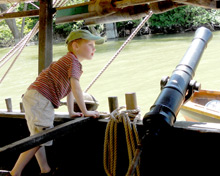
|
|
History comes alive at
at the Lake Champlain Maritime Museum.
|
The CVNHP is one of 49
national heritage areas (NHA) in the country. NHAs are regional efforts
established by the U. S. Congress, to promote resource stewardship and
connect citizens to the process of preservation, interpretation, and
marketing of heritage resources. This heritage area designation allows
the LCBP to provide financial and professional support to communities,
museums, and organizations that interpret and promote our region's
history and culture. Over the past 20 years, the LCBP has promoted interpretation
of the Champlain Valley's natural and cultural treasures in order to
build understanding, appreciation, and stewardship of these resources, so
there is already a strong foundation for this National Heritage Area
designation.
The planning process for the CVNHP began in 2008 and
included 38 public meetings throughout the region and in
Quebec. More than 872 people attended these meetings to discuss the
how the heritage area should be managed. In the legislation
authorizing the new heritage area, the Congress assigned the management
of the program to the LCBP. More than $220,000 in CVNHP grants have been
distributed by LCBP since 2008.
|
|
LCBP
WELCOMES STEPHANIE STROUSE
|
|
|
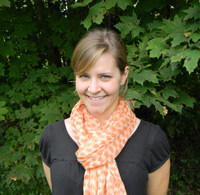
|
|
Stephanie Strouse
joined LCBP this summer.
|
The Lake Champlain Basin Program welcomed Stephanie Strouse
to the team this summer. Stephanie helps manage research grants and GIS
data throughout the Basin. She holds a B.A. in Environmental Science from
Franklin and Marshall College in Lancaster, PA and an M.S. in Fluvial
Geomorphology from Boston College. Her thesis research examined
dam-influenced sedimentation and land use change in a post-glacial
watershed using LiDAR, radiocarbon dating, and hydraulic modeling.
Stephanie's past work experience includes forest ecology research at
Harvard Forest, vineyard work, and fish tracking with the USGS in the
Columbia River Valley. Stephanie grew up on a farm and loves critters,
gardening, open spaces, and all things country. She lives in Burlington.
Welcome Stephanie!
|
|
IRENE
BRINGS MORE WATER QUALITY IMPACTS
|
|
|
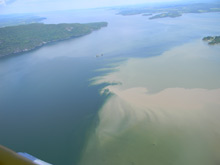
|
|
A
sediment plume at the mouth of Otter Creek two days following Tropical
Storm Irene, 2011.
|
Heavy
rains from Tropical Storm Irene brought record flooding to many Vermont
and New York tributary streams, book-ending what seemed an ironic very
dry period in a summer that started with record lake levels on Lake
Champlain. Flooding impacts from Irene were felt most acutely in the
tributaries in the southern sector of the Basin, where surging streams
devastated both infrastructure and personal property in many areas. While
lake levels increased rapidly, they remained far lower than the record
levels seen in spring. As with the spring floods, tributary floodwaters
again delivered large sediment and nutrient loads to the Lake.
Before Irene even hit,
Vermont Governor Peter Shumlin and Quebec Premier Jean Charest had sent a
joint letter to President Barack Obama and Prime Minister Stephen Harper
requesting that they charge the International Joint Commission (IJC) with
studying the causes of the spring flooding and proposing ways to mitigate
the impacts of future floods. Irene's devastation dramatically underscored
the need to learn from these intense natural disasters and proactively
plan for the future.
The Lake Champlain Basin Program was tasked with convening a
conference to explore flooding issues-including hazard mitigation,
shoreline stabilization, climate change, and infrastructure and ecosystem
impacts-and report to the Governors and the Premier. LCBP will host
meetings of scientists and resource managers in the region in the fall
and in follow-up meetings in 2012, to address these questions and make
recommendations to improve the flood resiliency of communities in the
Basin.
|
|
LAKE
CHAMPLAIN BASIN "TREES FOR TRIBS" PROGRAM LAUNCHED
|
|
|
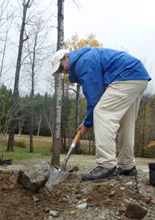
|
|
LCBP Technical
Coordinator Eric Howe getting his feet wet.
|
LCBP staff joined nearly
100 other volunteers to help kick of New York State Department of
Environmental Conservation's (DEC) "Trees for Tribs" tree
planting program this fall. Funded by the USDA Natural Resources
Conservation Service (NRCS) as part of President Obama's America Great
Outdoors (AGO) initiative, the program's goal is to restore and protect
stream corridors in the Lake Champlain Basin. The initial event focused
on stabilizing stream banks and reducing erosion in areas of the Ausable
River Watershed that were damaged during Tropical Storm Irene.
Volunteers, local
officials, and DEC and NRCS staff gathered in a light rain at Marcy Field
in Keene for a brief kickoff event before dispersing to several different
areas in the watershed to work. By the end of the day, rain was falling
steadily and sediment-laden runoff streamed off bare ground where
restoration work had been completed recently. In the course of the
afternoon, the streams rose steadily, carrying a chocolately-brown load
and making clear to the rain-soaked participants the need for the 1,000
trees they had planted.
The program, modeled after the "Trees for Tribs"
program started by the Hudson River Estuary Program in 2007, aims to
stabilize 20,000 feet of stream banks with trees provided by the Saratoga
State Tree Nursery. Additional plantings are planned, starting next
spring. DEC will be accepting applications from land owners and local
governments for technical assistance and low-cost or no-cost native
planting materials.
Visit DEC's website for more
information about the Lake Champlain Basin "Trees for Tribs"
Program.
|
|
ASIAN
CLAM TREATMENT AT LAKE GEORGE SUCCESSFUL, TO EXPAND TO OTHER SITES
|
This summer's effort by the Lake George Asian Clam Rapid
Response Task Force (LGACRRTF) to eradicate Asian clams from lake bottom
near Lake George Village has been largely successful where it was located
but, unfortunately, more infestations have been discovered. As the task
force prepares for the final stage of treatment at the site, it also is
deliberating on how best to control the invasive mollusks in other parts
of the lake where they recently have established themselves.
Sampling results by the team have found that 99% of the
clams have been killed in the area treated with benthic barrier mats
since April. Completion of this control plan at the Lake George Village
site remains the team's top priority. The team now will treat the five
percent of the site that was not part of the original effort, including
shallow beaches, rocky areas, and dock and wharf sites, with a
combination of mats and suction harvesting.
|
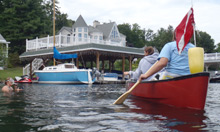
|
|
Task
force members survey for Asian clam infestations on Lake George. Photo
courtesy of Lake George Association.
|
The task force's
second priority is to continue its survey of potential additional
infestation sites in the lake. Over 70 sites have been surveyed to date,
and a similar number of areas remain. Unfortunately, several additional
sites of Asian clam infestation have been discovered. The process is slow
going, with snorkelers and divers inspecting and sieve sampling at a rate
of 0.2 miles per hour. Cooler water temperatures will make completing the
work this fall increasingly challenging.
The LGACRRTF is
heartened by new commitments of funding for treatment of Asian clams on
Lake George. The Warren County Board of Supervisors voted to allocate
$100,000 to the project. The Lake George Park Commission has committed an
additional $200,000 to the project and the Town of Bolton committed an
additional $5,000 for use in 2011 and has made a commitment for further
support in 2012.
Visit www.stoptheasianclam.info
to track the progress and sign up for automatic updates on the treatment.
|
|
CHAMPLAIN
BASIN EDUCATION INITIATIVE WEBSITE TO LAUNCH SOON
|
|
LCBP soon will launch WatershED Matters, a
website devoted to watershed education in the Lake Champlain Basin. LCBP
staff are developing the site in collaboration with curriculum specialist
and program partner Amy Demarest to support the Champlain Basin Education
Initiative (CBEI). CBEI is a consortium of environmental education groups
in the Basin that develops and conducts educator workshops and training.
WatershED Matters is intended to be a
resource for educators of all levels and subjects areas who are
interested incorporating watershed issues into their curriculum. The site
will feature strategy and process guidance for curriculum design, service
learning, and professional development as well as subject matter content
about specific watershed and water quality issues in the Basin and
beyond. Additionally, as the site continues to develop, it will house a
curriculum library that features materials developed as part of CBEI's
flagship professional development workshop "A Watershed for Every
Classroom."
Look for more information
soon at www.lcbp.org.

|
|
LCBP
NOW on FACEBOOK
|
|
The Lake Champlain Basin Program is now on Facebook. Head on over and like us. You can also
follow us on Twitter.
|
|
CONTACT US!
|
|
 Main
Office in Grand Isle: Main
Office in Grand Isle:
(802) 372-3213 or
(800) 468-5227 (toll-free in NY & VT)
LCBP
Resource Room: The Resource Room at The Leahy
Center for Lake Champlain (top floor of ECHO Lake Aquarium & Science
Center) is open to the public seven days/week. Call (802)
864-1848 ext. 109 for more information.
|
|
|
|
|